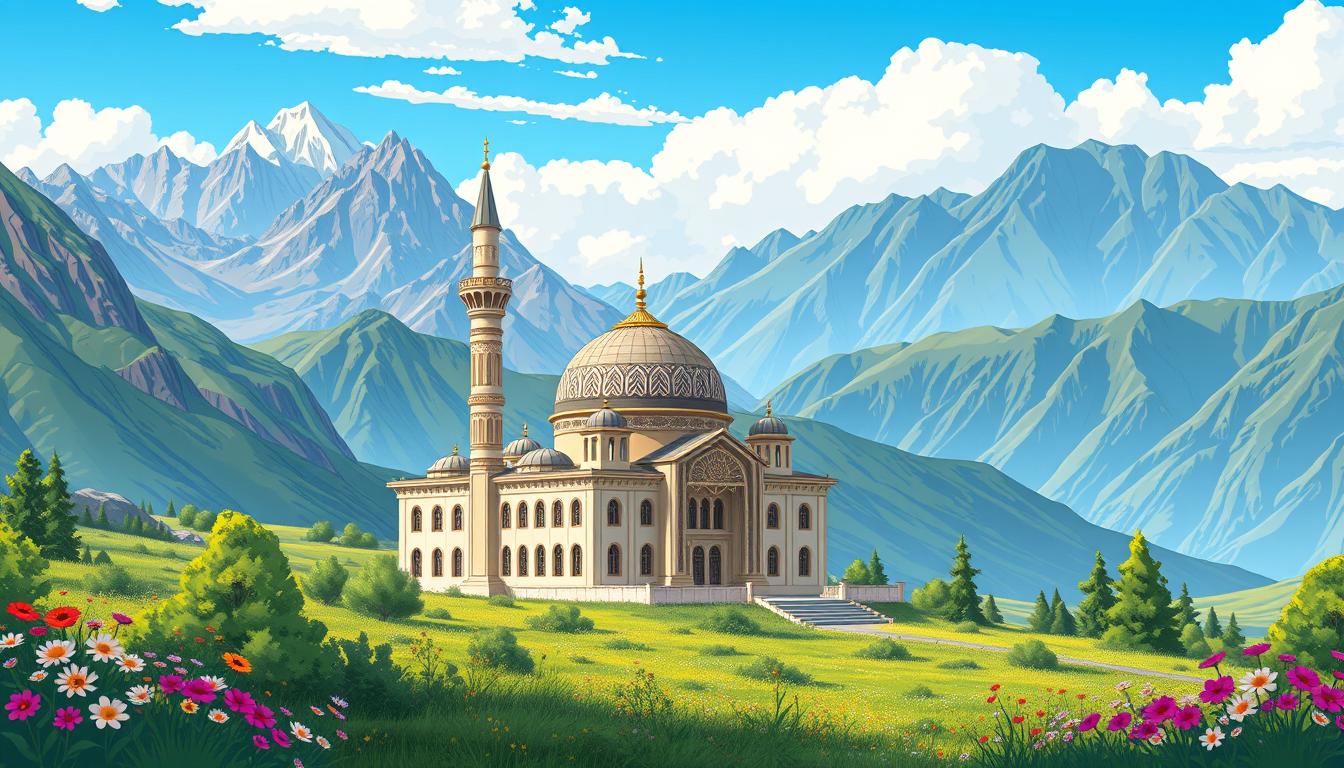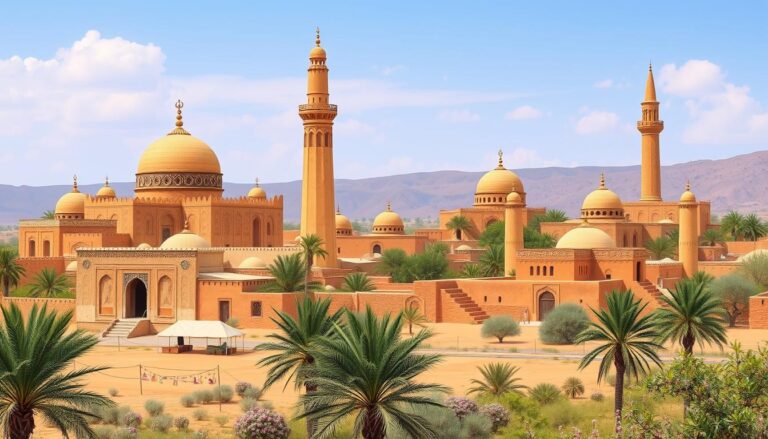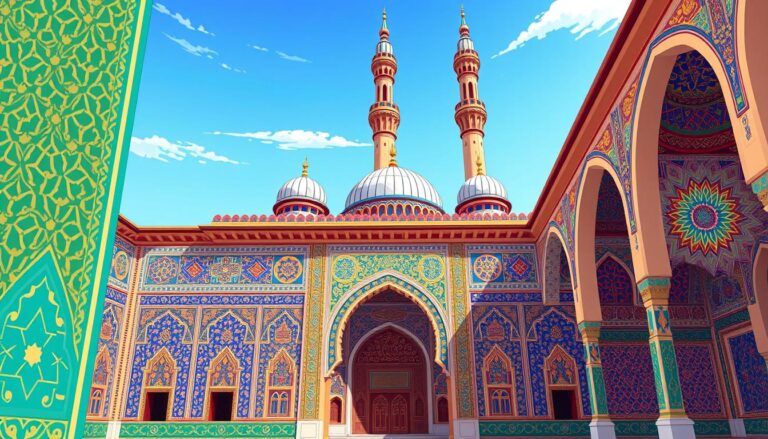Islam in Kyrgyzstan
Kyrgyzstan is a country where most people follow Islam. By 2020, about 90% of the population was Muslim. The Sunni branch, especially the Hanafi school, is the most common.
Islam arrived in Kyrgyzstan in the eighth century. But it became more widespread in the seventeenth century. By the late nineteenth century, all Kyrgyz people were Sunni Muslims. This change from Tengriism, a belief in spiritual kinship with animals, has influenced their Islamic practices and culture.
Even though Sunni Islam is the main faith, there are many other Muslim groups in Kyrgyzstan. These include Salafists, Tablighi Jamaat, and Nurjular. The country is becoming more open to different religious views.
Islam plays a big role in Kyrgyzstan’s culture and society. The government celebrates two Muslim holidays, Eid ul-Fitr and Eid ul-Adha. They also support Sunni Islam based on the Hanafi school.
But, the relationship between the state and religion is complex. There have been debates about banning abortion and making polygamy legal. The government has also banned foreign clothing, like the hijab, to protect national values and prevent extremism.
Introduction to Islam in Kyrgyzstan
Islam has been a big part of Kyrgyz culture and society for centuries. It was first introduced to the Kyrgyz tribes between the 8th and 12th centuries. Later, in the 17th century, the Jungars pushed the Kyrgyz into the Fergana Valley. This valley was already mostly Islamic.
Historical Overview of Islam’s Arrival and Spread
Even though the Jungars had an impact, the Kyrgyz people went back to some of their old customs as the danger went away. By the end of the 19th century, all Kyrgyz people, including those in the north, had become Sunni Muslims. This is the main branch of Islam in Kyrgyzstan today.
Significance of Islam in Kyrgyz Culture and Society
The Islamic influence on Kyrgyz culture is clear. The Kyrgyz people kept their pre-Islamic traditions and customs. These traditions don’t go against Islamic teachings, much like in Indonesia. This mix of Sunni Islam and Kyrgyz cultural practices has shaped the Kyrgyz identity over time.
“The Kyrgyz have also preserved pre-Islamic traditions and customs which are not contrary to the Islamic teachings, which is similar to what happened in Indonesia.”
Today, Islam in Kyrgyzstan is still very important to most people. The Sunni Islam is the main branch, and Tengrism traditions also play a role in the country’s culture.
Demographic Breakdown of Muslim Adherents
Islam is the main religion in Kyrgyzstan. The CIA World Factbook says 90% of people there are Muslim. Most of these Muslims follow Sunni Islam, the biggest branch in the country.
Sunni Islam as the Dominant Branch
Sunni Muslims are the biggest group in Kyrgyzstan, making up 87.18% of the population. Their presence shows how Islam spread through the area over time.
Minority Muslim Sects and Communities
Even though Sunni Islam is the main branch, there are smaller Muslim groups in Kyrgyzstan. The Shia Muslim community is estimated to be around 26,000 people in 2020. There’s also a small Ahmadiyya Muslim group, with about 1,000 members, according to 2020 data.
The Muslim population in Kyrgyzstan mainly includes ethnic Kyrgyz and Uzbek groups. On the other hand, the ethnic Russian population mostly follows the Russian Orthodox Church or Protestant denominations.
“Approximately 70% of the 1.2 billion Muslims in the world live in Asian countries, with fifteen countries in the region having a Muslim population exceeding 90% of the total population.”
Islam in Kyrgyzstan
Islam is deeply rooted in Kyrgyzstan, with over 90% of the country’s population of 6.1 million identifying as Muslim. The vast majority, around 90%, follow the Sunni branch of Islam. A small percentage, less than 1%, adhere to Shia Islam. Additionally, a modest Ahmadiyya Muslim community, estimated at around 1,000 individuals, is present in the country.
Kyrgyzstan’s Islamic landscape is further enriched by the presence of various Islamic institutions and organizations. As of 2007, there were 1,650 registered mosques in the country. The Muftiate (Spiritual Administration of Muslims of Kyrgyzstan-SAMK) serves as the highest Islamic governing body. It oversees all Islamic entities, including institutes, madrassahs, mosques, and Islamic organizations.
The Islamic culture in Kyrgyzstan is deeply intertwined with the country’s history and traditions. Mosques and Islamic institutions in Kyrgyzstan play a significant role. They serve as hubs for worship, education, and community gatherings.
“Islam has been a vital part of Kyrgyzstan’s identity for centuries, and its influence can be seen in every aspect of the country’s culture and society.”
As Kyrgyzstan continues to navigate the challenges of the modern era, the Islam in Kyrgyzstan remains a central pillar. It contributes to the rich tapestry of the country’s religious and cultural diversity.
Tribal Influences on Islamic Practices
Before Islam came, the Kyrgyz people mostly believed in Tengrism. This faith honored the spiritual bond with animals and nature. Even today, many Kyrgyz, especially in the north, still follow these old practices.
Pre-Islamic Tengrism and Shamanistic Traces
The Kyrgyz tribes used to worship animals like reindeer and bears. These beliefs, rooted in Tengrism, still shape their religious life. They share similarities with Siberian traditions.
Regional Variations in Religious Observance
In Kyrgyzstan, different regions have their own ways of worship. The north blends Islamic practices with old animist and shamanistic rituals. This mix shows the north’s unique religious practices, different from the rest of the country.
“The traditional Tengrist beliefs of the Kyrgyz people have left an indelible mark on the way they practice Islam, resulting in a rich tapestry of religious diversity across the country.”
The mix of Tengrism, Shamanism, and Islam has made Kyrgyzstan’s religious scene special. It shows the country’s rich cultural heritage and the lasting impact of its ancient traditions.
Role of Islam in the State and Politics
Islam has not been the main force in Kyrgyzstan’s politics. Yet, Islamic values are becoming more important. The country’s constitution says it’s secular, meaning no religion or ideology should rule the state. But, more people are now pushing for Islamic traditions in politics.
The influence of Islam in politics is clear. Local governments are building bigger mosques and religious schools. They also want to make polygamy legal and let officials go on the hajj without paying taxes. This shows how Islamic practices are becoming part of the country’s laws.
Constitutional Provisions and Legal Framework
The constitution of Kyrgyzstan supports secularism. But, the role of Islam in politics is still debated. Over 2,900 mosques and madrassas have opened in the last 30 years. This growth is thanks to help from Arab foundations.
More politicians are showing their faith to win votes. People see them as honest and just. This has led to talks about Islamic values in parliament.
Islam’s role in politics in Kyrgyzstan comes from many reasons. These include a cultural crisis, lack of religious education, outside influences, and corruption. These factors have made Islamic values more present in politics. This brings both challenges and chances for Kyrgyzstan’s democracy.
Islamic Institutions and Organizations
Kyrgyzstan is home to many Islamic institutions and organizations. These groups are key to the country’s religious life. The Muftiate, or Spiritual Administration of Muslims of Kyrgyzstan (SAMK), is at the heart of this. It was set up in 1993 as the top Islamic body in the nation.
The Muftiate and Its Responsibilities
The Muftiate looks after all Islamic places in Kyrgyzstan. This includes institutes, madrassahs, mosques, and Islamic groups. The Mufti, chosen by the Council of Ulemas, leads the Muftiate. This council is made up of 30 Islamic scholars and clerics.
The Muftiate makes sure Islamic books are taught correctly. It can stop books that don’t meet its standards. The Kyrgyz government helps the Muftiate with this effort.
“The Muftiate plays a vital role in regulating Islamic institutions in Kyrgyzstan and promoting the country’s religious harmony.”
The Muftiate works hard to keep Islamic practices true. It also fights against extremist ideas in Muslim communities.
Islamic Education and Madrasas
Kyrgyzstan, with its deep Islamic roots, has seen a big increase in religious schools. By 2023, the State Commission on Religious Affairs (SCRA) reported 130 institutions for Islamic education. This includes 34 madrasahs for girls who have finished ninth grade.
Islamic education in Kyrgyzstan is varied, with over 6,000 female students in these schools. These students are usually 15 and older. This is more than in neighboring countries like Kazakhstan and Uzbekistan, showing Kyrgyzstan’s openness to religious freedom.
Madrasahs like Abdiraim Kari teach more than just religion. They also offer classes in computing, design, sewing, and sports. But, there are worries about the quality of teaching and if these schools meet national standards. This led to the closure of 21 Islamic schools in Osh Province in 2023.
The impact of Islamic education in Kyrgyzstan is debated. Some say it needs reform and better oversight. Madrasah diplomas allow graduates to teach Islamic sciences. But, finding jobs outside of religious schools is hard, and these diplomas are not recognized at secular universities.
“Concerns about the content and effectiveness of Islamic education in Kyrgyzstan have been raised by activists both within the Islamic community and globally.”
Kyrgyzstan is trying to balance religion, education, and society. The changes in its Islamic education system will affect its future and ties with the Muslim world.
Religious Diversity and Coexistence
Kyrgyzstan is a country with many different religious beliefs. Islam is the main religion, with over 80% of people identifying as Muslim. But, the country also has many other faiths like Christianity, Buddhism, and Judaism.
Minority Faiths and Their Status
About 7% of the people in Kyrgyzstan are Christian, with the Russian Orthodox Church being the second-largest. The rest of the Christians are split among different groups. There are also small groups of Jews, Buddhists, and Baháʼís, making up about 3% of the population.
Kyrgyzstan has always been a place of religious diversity in Kyrgyzstan. Ancient towns had people from many faiths living together. Even in the 13th century, different religions like Tengrism and Christianity coexisted.
Even though Islam is the main religion, religious coexistence in Kyrgyzstan is generally good. Minority faiths can practice their beliefs freely. The government works to protect the rights of all religious groups.
“Pluralism has historically been followed by peace and prosperity in Kyrgyzstan.”
Challenges and Concerns
Kyrgyzstan is dealing with big issues in the area of religion. It’s trying to fight religious extremism and radicalization. The government has banned 21 groups it sees as extremist. It has also detained at least 39 people for sharing banned religious materials.
NGOs say the government arrests people for sharing extremist content online. This includes liking or sharing posts from banned groups. But, this method worries many because it mixes violent extremists with those who have committed less serious crimes. This is especially true for women in prison.
Combating Extremism and Radicalization
Kyrgyzstan is using many ways to tackle religious extremism and radicalization. The country has seen a lot of political turmoil, including two violent uprisings in 2005 and 2010. This has led to many young people becoming radicalized, especially in the Fergana Valley.
- It’s important to have good programs to stop violence in Kyrgyzstan and Central Asia.
- Improving women’s status in Kyrgyzstan is also key in fighting radicalization.
- NGOs are concerned about fair treatment of those accused of having extremist materials.
As Kyrgyzstan tackles these issues, finding a balance is essential. It needs to keep people safe while also protecting their rights and freedoms. This is crucial for dealing with religious extremism, radicalization, and security issues in the country.
Cultural Celebrations and Festivals
Kyrgyzstan is a country filled with Islamic traditions. It celebrates many cultural festivities all year round. These celebrations show off the country’s diverse heritage in a joyful way.
Observance of Islamic Holidays and Traditions
Kyrgyzstan is mostly Muslim. It celebrates two big Islamic holidays as national days off: Eid ul-Fitr (Öröz Ayt) and Eid ul-Adha (Kurban Ayt). Eid ul-Fitr ends Ramadan, and Eid ul-Adha honors the Prophet Ibrahim’s sacrifice.
These holidays are marked with animal sacrifices, mosque prayers, and big family meals. The country also celebrates Nooruz (Nowruz), the Persian new year, as a national holiday.
Kyrgyzstan also honors Orthodox Christmas on January 7th. This shows the country’s religious diversity and how different faiths live together.
“The cultural celebrations in Kyrgyzstan are a vivid tapestry, weaving together the country’s Islamic heritage, national identity, and religious pluralism.”
Kyrgyzstan’s cultural calendar is full of celebrations. From Independence Day and Victory Day to International Women’s Day, the country celebrates its history, traditions, and people’s diversity.
Conclusion
In summary, Islam is the main religion in Kyrgyzstan, with over 90% of people identifying as Muslim, mostly Sunni. This religion deeply affects Kyrgyz culture and society. Pre-Islamic traditions also play a role.
The country is secular but works to promote Islamic values. This includes reforming the Spiritual Administration of Muslims in Kyrgyzstan.
The growth of Islamic organizations and mosques is significant since the USSR fell. The state and religious groups have close ties. Religious education is becoming more popular in both cities and rural areas.
However, the country faces challenges like fighting religious extremism. It also needs to protect the rights of minority faiths in its diverse religious scene.
Islam is a key part of Kyrgyzstan’s culture and society. It shapes the daily lives of its people and influences policies and institutions. As the nation deals with religious revival and coexistence, understanding Islam’s role is vital for a harmonious society.
Source Links
- Islam in Kyrgyzstan
- Kyrgyzstan Attempts to Isolate Local Islam
- ISLAM IN KYRGYZSTAN | Facts and Details
- Religious Liberalization and Civil Islam in Kyrgyzstan
- National Profiles | World Religion
- The Demographics of Islam in Asia – Association for Asian Studies
- Kyrgyzstan – United States Department of State
- Religion and the Secular State in Kyrgyzstan
- The Processes of Politicizing Islam in Kyrgyzstan: Impact on the 2020 Parliamentary Elections
- Society and Islamist Ideas in Kyrgyzstan
- Religion in Kyrgyzstan
- Religion and the Secular State in Kyrgyzstan – Silk Road Paper
- Booming Demand For Madrasahs Fuels Islamization Concerns In Kyrgyzstan
- The topic of interest to the neighbors: the girls’ madrasa in Kyrgyzstan
- Religious Diversity in Kyrgyzstan: A Believer is a Man and a Citizen, First of All
- “We Live in Constant Fear”
- Kyrgyz national holidays – Central Asia Tours
- Kyrgyz Holidays 2024: A Complete Guide
- Insight into Kyrgyz identity through hats, hijabs, and other types of head-coverings
- No title found
- Religious Politics in Kyrgyzstan: Analysis of Achievements and Issues
- Islam and the Norms of Kyrgyz Society – Central Asia Program







